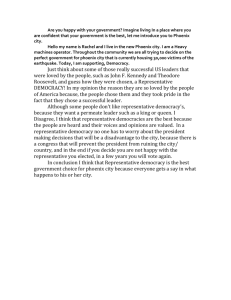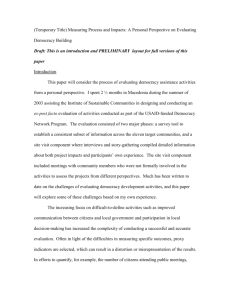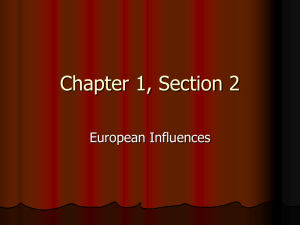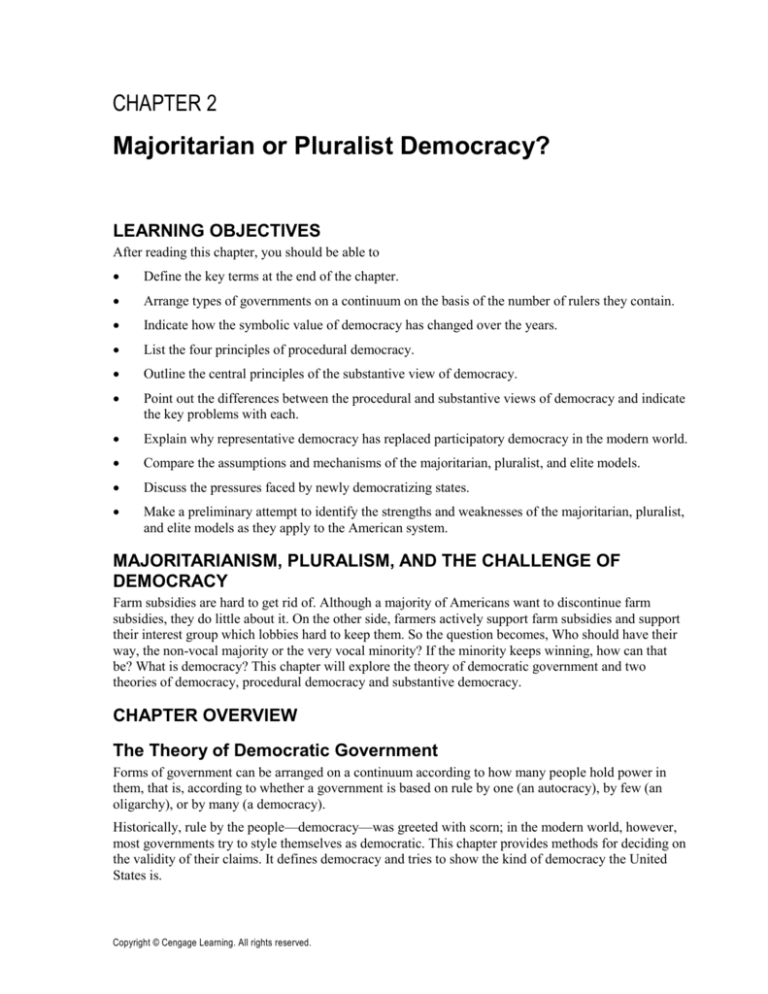
CHAPTER 2
Majoritarian or Pluralist Democracy?
LEARNING OBJECTIVES
After reading this chapter, you should be able to
Define the key terms at the end of the chapter.
Arrange types of governments on a continuum on the basis of the number of rulers they contain.
Indicate how the symbolic value of democracy has changed over the years.
List the four principles of procedural democracy.
Outline the central principles of the substantive view of democracy.
Point out the differences between the procedural and substantive views of democracy and indicate
the key problems with each.
Explain why representative democracy has replaced participatory democracy in the modern world.
Compare the assumptions and mechanisms of the majoritarian, pluralist, and elite models.
Discuss the pressures faced by newly democratizing states.
Make a preliminary attempt to identify the strengths and weaknesses of the majoritarian, pluralist,
and elite models as they apply to the American system.
MAJORITARIANISM, PLURALISM, AND THE CHALLENGE OF
DEMOCRACY
Farm subsidies are hard to get rid of. Although a majority of Americans want to discontinue farm
subsidies, they do little about it. On the other side, farmers actively support farm subsidies and support
their interest group which lobbies hard to keep them. So the question becomes, Who should have their
way, the non-vocal majority or the very vocal minority? If the minority keeps winning, how can that
be? What is democracy? This chapter will explore the theory of democratic government and two
theories of democracy, procedural democracy and substantive democracy.
CHAPTER OVERVIEW
The Theory of Democratic Government
Forms of government can be arranged on a continuum according to how many people hold power in
them, that is, according to whether a government is based on rule by one (an autocracy), by few (an
oligarchy), or by many (a democracy).
Historically, rule by the people—democracy—was greeted with scorn; in the modern world, however,
most governments try to style themselves as democratic. This chapter provides methods for deciding on
the validity of their claims. It defines democracy and tries to show the kind of democracy the United
States is.
Copyright © Cengage Learning. All rights reserved.
14
Chapter 2: Majoritarian or Pluralist Democracy?
The authors present two different theories of democracy. The first is a procedural theory and
emphasizes how decisions are made. It relies on four main principles: universal participation, political
equality, majority rule, and responsiveness of representatives to the electorate. Under the requirements
of the procedural theory, there need be no protections for minorities. The second theory is a substantive
one and pays more attention to the content of what government does. Substantive theorists generally
expect the government to protect the basic civil rights and liberties of all, including minorities; some
substantive theorists go further and expect the government to ensure various social and economic rights.
The difficulty with substantive theory is that it is hard to reach agreement on the scope of government
action to bring about social and economic equality.
Institutional Models of Democracy
Democracies of today are representative democracies rather than participatory democracies. They
require institutional mechanisms to translate public opinion into government policies. These
institutional mechanisms may be designed to tie government policies closely to the will of the majority,
or they may be structured to allow groups of citizens to defend their interests before government.
The classic model of democracy is the majoritarian model. It assumes a population of knowledgeable
voters who willingly go to the polls to vote on issues and to select candidates who they believe will best
represent them. The main tools of majoritarian democracy are elections, referenda, and initiatives.
(Although public opinion in the United States supports national referenda, referenda and initiatives are
available only at the state and local level.) While proponents of majoritarian democracy point to the
stability of public opinion and to the desire of many Americans to become more involved in politics,
critics argue that majoritarian assumptions do not correspond very well to U.S. political reality. For
example, in the United States, citizens are not well informed and voter turnout is low. However, many
voters make their choices with just a little information.
A second model, the pluralist model, better reflects the limited knowledge and participation of the real
electorate. It envisions democratic politics taking place within an arena of interest groups. This model
relies on open access that allows individuals to organize into groups to press their claims on multiple
centers of government power (Congress, state legislatures, bureaucratic agencies, and so on).
A third model, elite theory, which is also discussed in this chapter, is more of an antidemocratic theory.
Elite theory maintains that democracy is a sham, since power is really in the hands of a small number of
individuals who control all government decisions and manipulate the political agenda. However,
although in U.S. politics a small group of people can have a big impact, different groups affect different
issues. This observation tends to undermine elite theory.
Politics of Global Change
As China created a new market economy, democratic values crept into China’s government system.
Some people are expecting that freedom in the economic realm will translate into freedom of the
political realm. Although the government now allows groups to organize and criticize their government,
the Communist Party is trying to retain control. Over time, some people think, pressure will build to
allow free elections and more citizen involvement in policymaking.
The Global Trend Toward Democracy
No government lives up fully to the standards of either the pluralist or the majoritarian model, but some
nations come close enough to be called democracies.
Democracies have been rare throughout history. Democratization can only be achieved with great
difficulty. Many nations who start the democratization process fail because of deep-seated differences
in their societies. U.S. efforts to introduce democracy in Afghanistan and Iraq have focused attention on
Copyright © Cengage Learning. All rights reserved.
Chapter 2: Majoritarian or Pluralist Democracy?
15
the problems related to building new democracies. Struggles in these countries show that the transition
to democracy is not easy and may be complicated by economic difficulties and ethnic tensions.
Does the United States qualify as a democracy? The authors contend that it does, and in this chapter and
throughout the text they explore which model best describes American democracy. They argue that the
pluralist model more closely conforms to the American system than either the elitist or the majoritarian
model. At the same time, there are signs that the American system is becoming more majoritarian,
because people seem to think that the pluralist system has not served the United States very well.
KEY TERMS
autocracy
oligarchy
democracy
procedural democratic theory
universal participation
political equality
majority rule
participatory democracy
representative democracy
responsiveness
substantive democratic theory
minority rights
majoritarian model of democracy
interest group
pluralist model of democracy
elite theory
democratization
RESEARCH AND RESOURCES
The first chapter of this guide introduced you to specialized encyclopedias and dictionaries. Those
fairly massive works are not updated very frequently, and they are geared to provide an introduction to,
or an overview of, a subject. If you need in-depth information, you will probably want to start by
looking for books on your subject. For that, begin with the Internet gateway that lets you search for
books in your library. Visit the catalogs of other libraries, because your library may be able to borrow
the book you need through an interlibrary loan service.
Since the process of writing, editing, and publishing books takes months, you will not usually find the
most up-to-date information in books. Supplement your search by checking periodical indexes,
journals, and newspapers. For help in locating specialized periodical literature in political science, try
the four excellent indexes listed here. These indexes have long been available in paper form, but many
college and university libraries now have access through the Web. Check with your librarian.
1.
ABC POL SCI. Santa Barbara, CA: ABC-Clio. This index specializes in publications on political
science and government. It includes foreign and non-English-language materials and is a little
Copyright © Cengage Learning. All rights reserved.
16
Chapter 2: Majoritarian or Pluralist Democracy?
harder to use than either of the next two. The subject index in the back of this work gives you
reference numbers for articles. The articles are listed by reference number in the front of the
volume.
2.
Public Affairs Information Service (PAIS). New York: Public Affairs Information Service. This
index includes books, government publications, and reports of public and private agencies, in
addition to periodical articles on government, economic and social conditions, and business and
international relations. Articles are indexed by subject.
3.
Social Sciences Index (SSI). New York: H. W. Wilson Company. This index covers Englishlanguage periodicals in the social sciences, including anthropology, economics, environmental
sciences, geography, law criminology, planning, public administration, psychology, social aspects
of medicine, and sociology, as well as political science. Articles are indexed by subject and by
author.
4.
LexisNexis, a division of Reed Elsevier, provides online access to a wide variety of news articles
about government, politics, business, and law. Many colleges have either the full version available
or its somewhat scaled-down sibling, Academic Universe.
USING YOUR KNOWLEDGE
1.
Check with your college library to see which paper and online indexes mentioned above are
available for your use. Select at least two of the following—SSI, ABC POL SCI, PAIS, or
LexisNexis—and look for works on democracy published in the last year. After you have located
democracy in the indexes, browse through the list of titles, narrow your focus, and prepare a short
bibliography on some aspect of democracy. (Examples might include “Democracy in the Third
World,” “Democracy in Eastern Europe,” “Pluralist Democracy,” “Democracy in America,” and
“Measuring Democracy throughout the World.”)
2.
A number of websites devoted to democracy are indexed in the Google Directory at
<http://directory.google.com/Top/Society/Politics/Democracy>. Visit some of these websites and
describe the form of democracy advocated there. In particular, note whether each site supports a
form of democracy that is more pluralist or more majoritarian.
SAMPLE EXAM QUESTIONS
Multiple-Choice Questions
1.
2.
What was the original purpose of the farm subsidies program in the 1920s?
a.
stabilize food choices
b. offer more options for farmland production
c.
develop new species of crops
d. stabilize food prices
e.
cause prices to fall
What term do we use to describe government power in the hands of a few powerful elite?
a.
autocracy
b. democracy
c.
dictatorship
d. monarchy
e.
oligarchy
Copyright © Cengage Learning. All rights reserved.
Chapter 2: Majoritarian or Pluralist Democracy?
3.
4.
5.
6.
7.
8.
9.
What term do we use to describe a politician who appeals to and deceives the masses by
manipulating their emotions?
a.
legislator
b. demagogue
c.
elitist
d. populist
e.
dictator
Which of the following is not one of the four principles of the procedural theory of democracy?
a.
political equality
b. responsiveness
c.
protection of minorities
d. universal participation
e.
majority rule
What term is best used to describe the concept of one vote per person?
a.
universal equality
b. universal egalitarianism
c.
unicameral legislation
d. political equality
e.
political leveling
What do we call the concept that everyone in a group must meet to make decisions, while
observing political equality and majority rule?
a.
substantive theory of democracy
b. procedural theory of democracy
c.
elite theory of democracy
d. initiative and referenda
e.
none of the above
Which principle does procedural theory consider absolute?
a.
political equality
b. responsiveness
c.
protection of minorities
d. universal participation
e.
majority rule
The majoritarian model of democratic government
a.
offers protection for minority rights.
b. relies on a relatively passive citizenry.
c.
is organized around the activities of groups.
d. expects citizens to have a high degree of knowledge.
e.
fits well with the behavior of voters in America.
What is the form of democracy that selects individuals to govern on the behalf of others called?
a.
minority rule
b. indirect democracy
c.
participatory democracy
d. procedural democracy
e.
representative democracy
Copyright © Cengage Learning. All rights reserved.
17
18
Chapter 2: Majoritarian or Pluralist Democracy?
10. Approximately what proportion of Americans describe democracy by mentioning freedom, rights,
and liberties?
a.
one-quarter
b. one-third
c.
one-half
d. two-thirds
e.
three-quarters
11. What is the primary mechanism for democratic government in the majoritarian model?
a.
universal participation
b. popular election
c.
aristocracy
d. elitism
e.
policy
12. Which of the following is not among the watchwords associated with pluralist democracy?
a.
one person, one vote
b. divided authority
c.
decentralization
d. open access
e.
government by groups
13. What do we call a special election to unseat an elected official?
a.
referendum
b. recall
c.
procedural election
d. initiative
e.
universal election
14. What factors are expected to motivate public officials to be responsive?
a.
campaign financing and redistricting
b. recall and referendum
c.
reelection and the prospect of defeat at the polls
d. watchdog groups and television
e.
lobbyists and coalitions
15. Elite theory appeals to people who believe
a.
the public should be actively engaged in politics.
b. direct democracy is the only true democracy.
c.
in the principle of responsiveness.
d. government should respond to the demands of many groups.
e.
wealth dominates politics.
16. What do we call a model of government that places a high value on participation through
organized groups?
a.
elitism
b. substantive democracy
c.
pluralism
d. socialism
e.
majoritarianism
Copyright © Cengage Learning. All rights reserved.
Chapter 2: Majoritarian or Pluralist Democracy?
17. What is the key to the success of a majoritarian democracy?
a.
popular participation
b. the presence of many organized groups
c.
decentralized government
d. economic equality
e.
low citizen involvement in civic affairs
18. The two major mechanisms of a pluralist democracy are interest groups and
a.
centralized hierarchy.
b. liberal campaign financing rules.
c.
popular elections.
d. decentralized structure of government.
e.
capitalism.
19. What do we call the fundamental idea that government responsiveness comes through mass
political participation?
a.
substantive democracy
b. majoritarian democracy
c.
minority rights
d. pluralist democracy
e.
elitist theory
20. The observed relationship between democracy and economic performance suggests that
democratic nations are
a.
no more or less prosperous than nondemocratic nations.
b. less prosperous than nondemocratic nations.
c.
less likely to support free markets than nondemocratic nations.
d. more prosperous than nondemocratic nations.
e.
retarding global economic growth.
21. Roughly what percentage of the American population follows what’s going on in government
most of the time?
a.
12 percent
b. 18 percent
c.
26 percent
d. 39 percent
e.
43 percent
22. The United Nations has tracked the number of democracies around the world and noticed an
increase in their number from 1990 to 2003. What percentage increase did the world see in the
number of democracies between 1990 and 2003?
a.
3 percent
b. 7 percent
c.
10 percent
d. 13 percent
e.
16 percent
23. Democratic governments and processes
a.
guarantee correct decisions.
b. are observed in nearly all contemporary nations.
c.
always protect minority rights.
d. reject unlimited majority rule.
e.
may not necessarily result in desirable policies.
Copyright © Cengage Learning. All rights reserved.
19
20
Chapter 2: Majoritarian or Pluralist Democracy?
24. The principle of majority rule conflicts most directly with
a.
popular sovereignty.
b. minority rights.
c.
universal participation.
d. a sense of community identity.
e.
government responsiveness.
25. According to the theory of American democracy, what is the fundamental principle which
provides social glue to generate trust and cooperation in the political system?
a.
civic participation
b. popular elections
c.
campaign financing
d. universal participation
e.
decentralized government
Essay Questions
1.
What are the principal assumptions of each of the models of democracy? Are assumptions of
either model more likely to be satisfied in practice?
2.
Explain how the principles of procedural democracy may threaten liberty.
3.
Advocates of participatory democracy maintain that all citizens must engage in the business of
government and that government institutions should encourage this type of universal participation.
What are the merits and disadvantages of this type of democratic governance? How have social
changes undermined efforts to expand this type of participation in governance?
4.
Explain how an economy built around a private sector and market forces are changing China’s
government.
5.
Discuss the difficulties of democratization and the forces that tend to interrupt that process.
Copyright © Cengage Learning. All rights reserved.
Chapter 2: Majoritarian or Pluralist Democracy?
ANSWERS TO MULTIPLE-CHOICE QUESTIONS
1.
d
2.
e
3.
b
4.
c
5.
d
6.
e
7.
b
8.
d
9.
e
10. d
11. b
12. a
13. b
14. c
15. e
16. c
17. a
18. d
19. b
20. d
21. c
22. e
23. e
24. b
25. a
Copyright © Cengage Learning. All rights reserved.
21



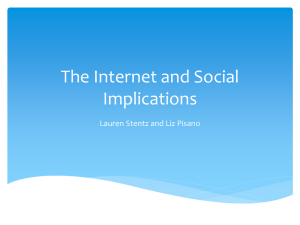
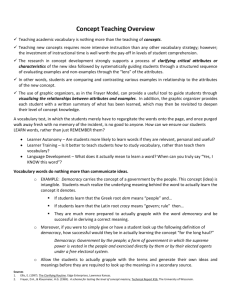
![“The Progress of invention is really a threat [to monarchy]. Whenever](http://s2.studylib.net/store/data/005328855_1-dcf2226918c1b7efad661cb19485529d-300x300.png)
